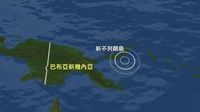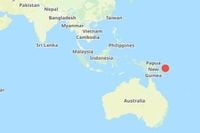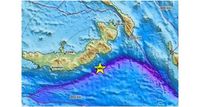On April 5, 2025, a magnitude 6.9 earthquake struck near New Ireland, Papua New Guinea, prompting immediate tsunami warnings for coastal areas. The earthquake, which occurred at 4:05 AM Taiwan time (6:04 AM local time), was initially reported as a 7.2 magnitude by the United States Geological Survey (USGS) before being revised down to 6.9. This seismic event, with a depth of approximately 10 kilometers, raised alarms about potential tsunami waves reaching heights of 1 to 3 meters along parts of the Papua New Guinea coastline.
The U.S. Tsunami Warning Center quickly issued warnings, cautioning that “some coastal areas are predicted to have dangerous tsunami wave heights.” While the Solomon Islands were expected to see wave heights lower than 0.3 meters, the threat level for Papua New Guinea was significant enough to prompt authorities to advise coastal residents to remain vigilant and monitor official updates.
As of the latest reports, there have been no confirmed casualties or property damage associated with the earthquake. This lack of immediate impact is a relief to local communities, which are often on high alert due to Papua New Guinea's location along the Pacific Ring of Fire, a region known for its frequent seismic activity.
The Pacific Tsunami Warning Center later confirmed that the tsunami threat had been lifted, allowing residents to breathe a sigh of relief. Despite the initial fears, the swift response from geological agencies and emergency services appears to have mitigated potential disaster.
Seismologists note that Papua New Guinea is situated at the convergence of several tectonic plates, making it particularly susceptible to earthquakes. The region's geological instability is a reminder of the ongoing natural forces at play beneath the Earth's surface.
In the aftermath of the earthquake, local authorities have been assessing the situation closely, ensuring that communities are prepared for any aftershocks or related seismic activity. The USGS and other geological organizations continue to monitor the region, providing updates and guidance to both residents and emergency responders.
As the day progresses, residents are encouraged to stay informed through official channels and heed any warnings or advice from local authorities. The earthquake serves as a stark reminder of the potential dangers posed by natural disasters in this seismically active region.
With the immediate threat of a tsunami having passed, the focus now shifts to recovery and preparedness for future seismic events. Educational initiatives on earthquake safety and preparedness are crucial in a region that faces such risks regularly.
In the coming days, experts will analyze data from this earthquake to better understand its characteristics and implications for future seismic activity in the region. The importance of preparedness cannot be overstated, as communities in Papua New Guinea continue to adapt to the realities of living in a geologically dynamic area.
Overall, while the earthquake's magnitude and potential tsunami threat raised alarms, the current situation reflects a successful response from emergency services and geological agencies, highlighting the importance of readiness in the face of natural disasters.








